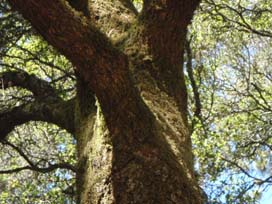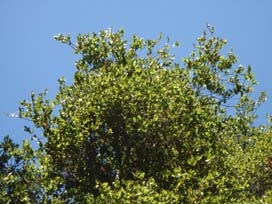







shreve oak
Quercus parvula var. shrevei
Family: Fagaceae.
Type: Evergreen tree.
Branching: Alternate.
Oak Group: Black.
Leaves: Simple, with a sharp tip. Older leaves tend to be entire, while younger leaves are often, but not always, toothed; this is a good way to distinguish shreve oak from relatives. Another important characteristic is that its leaves are green and shiny on both sides; both surfaces are essentially the same, although the underside may be slightly lighter. Leaves are more or less flat; they do not curve or cup, unlike those of coast live oak.
Twig: See photos; not commented upon.
Fruit & Flower: Acorn development takes two years in the shreve oak, so new twigs will have immature acorns; mature acorns will be on last year's twig, and this is a good way to distinguish the shreve from the coast live oak. Acorns are long and narrow, with scales on the cap that are flat and pressed smoothly down upon the cap.
Miscellaneous: Shreve oak is found in moist coastal areas, with coast live oak or in a mixed evergreen setting. It is a moisture-demanding oak, so it will not be seen in drier areas immediately around San Jose. The shreve oak is a black oak, richer in tannins than a white oak.
 |
 |
 |
 |
 |
 |
 |
 |